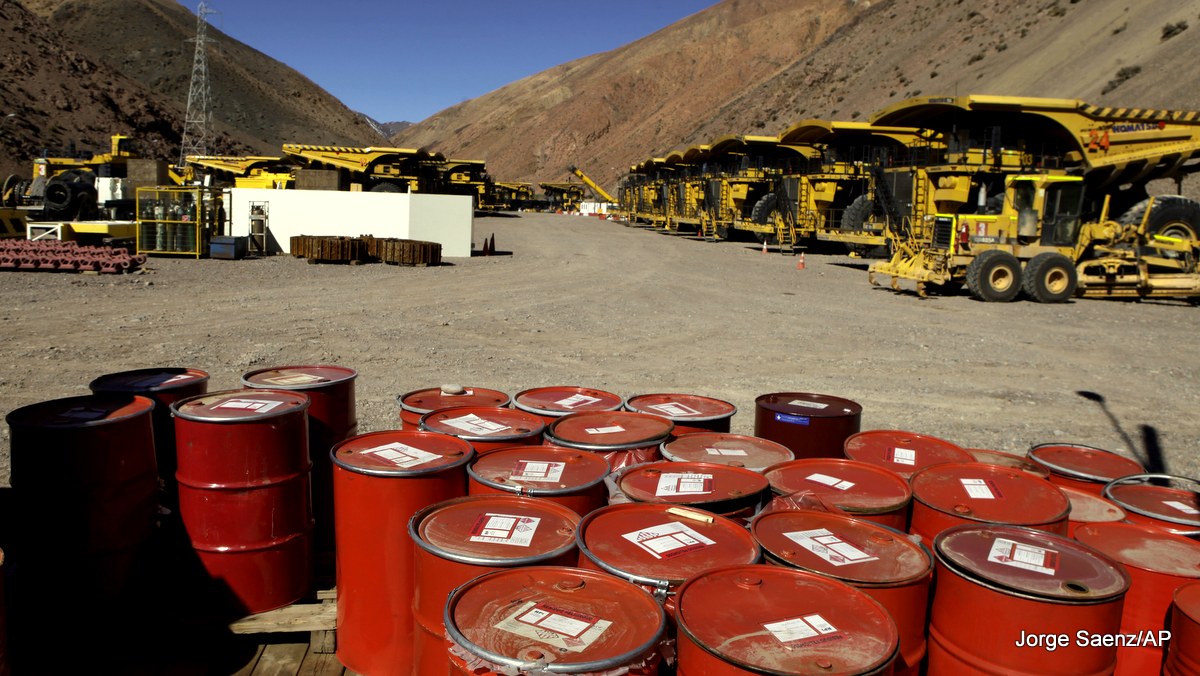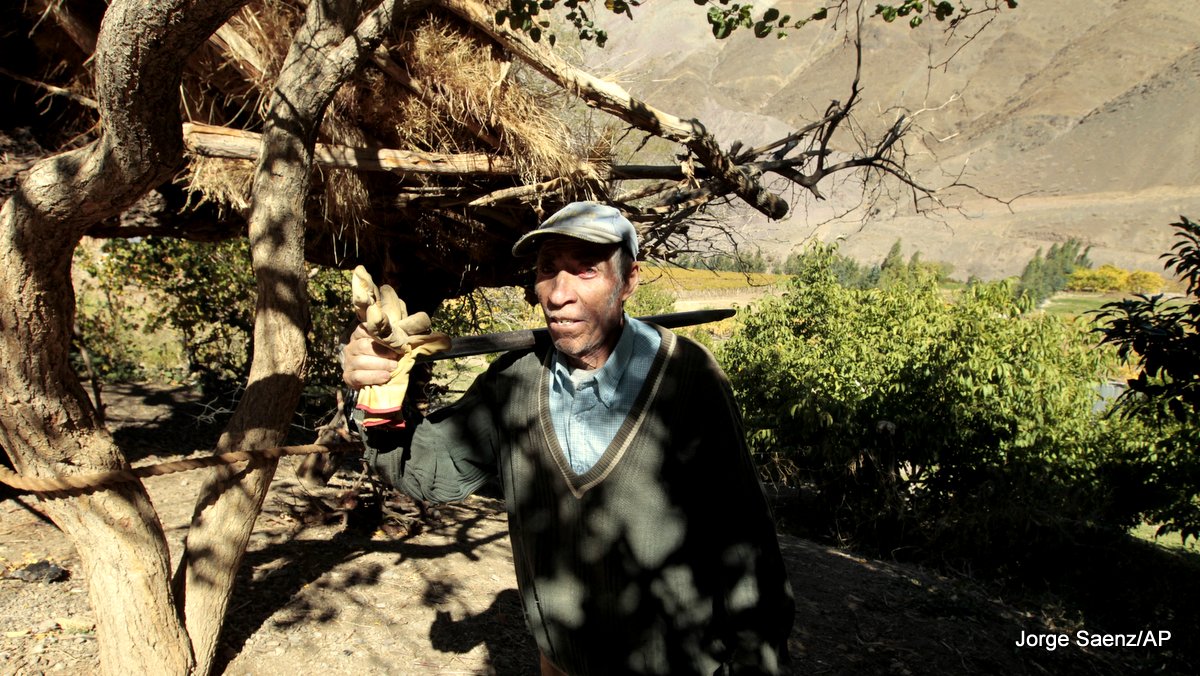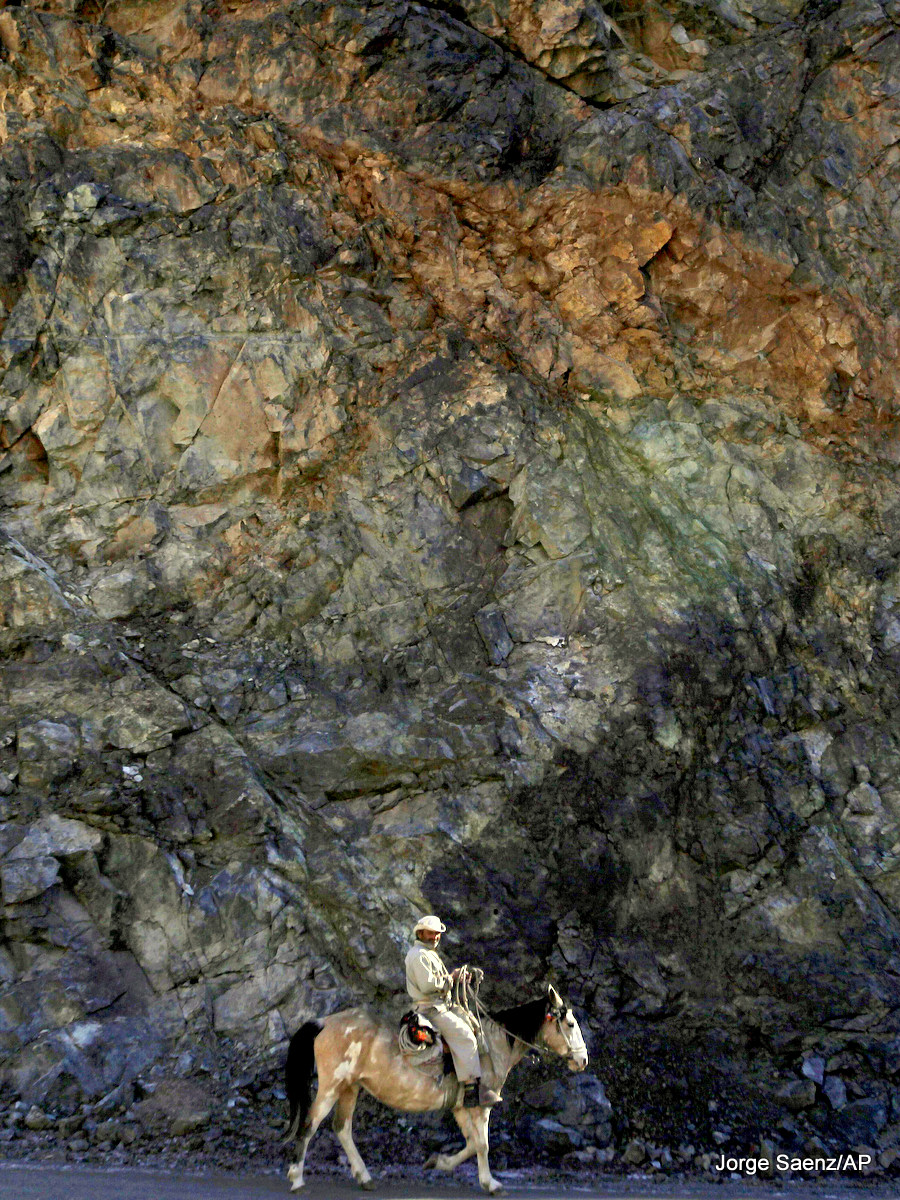| Chilean Farmers And Foreign Mining Firms Face Off Over Andes Gold by Ramona Wadi, MintPress News December 1st, 2014 |
Straddling the Chile-Argentina border high in the Andes, Canadian miner Barrick Gold�s Pascua Lama mining project has long been a source of controversy. The area is rich in gold, silver, copper and other mineral resources, but their extraction runs counter to the needs and interests of nearby indigenous communities and would have disastrous environmental consequences. Environmental Impact Assessments (EIA) for the project were conducted for both Chile and Argentina, and both countries approved these EIA in 2006 following lengthy reviews. However, last year, Chilean courts fined Barrick Gold $16 million
for environmental violations � notably, the lack of a viable system for
treating contaminated water as well as preventing rainwater
contamination. Construction of the mining project was suspended in
January of this year, with Barrick Gold citing �the prolonged lower metals prices and continued uncertainty and risk� as reasons to halt the project.
Juan Guerrero rides past a wall of rock as he rides into El Corral, a small town of about 200 inhabitants, mostly from the Diaguita ethnic group, near the facilities of Barrick Gold Corp�s Pascua-Lama project in northern Chile. Meanwhile, the environmental issues stemming from the project, which was developed by Minera Nevada S.A. in Chile, and Barrick Exploraciones Argentina S.A. and Exploraciones Mineras Argentinas S.A. in Argentina, have given rise to a constant battle between the indigenous population and the multinational corporations exploiting them � particularly Barrick Gold. In 2011, nueva canci�n singer Patricio Manns participated in the Festival Vi�a del Mar, performing �De Pascua Lama,� a song which articulates the valid concerns raised by Chileans and indigenous communities alike � notably the negative impacts to the livelihoods of communities in the area for the gains of the planned 20-year endeavor. For example, cyanide used in the mines contaminates local water sources, affecting farming operations in the Huasco Valley, which depend upon irrigated water derived from the glaciers in the Andes. Additionally, although Barrick Gold, the world�s largest gold producer, offered mining work to indigenous communities, the project would only provide employment for a stipulated period for a percentage of workers. Due to the project�s impact on nearby farmland, permanent unemployment and lack of opportunities for the indigenous communities to make a living represent very real long-term ramifications.
Going forward?
Mining machinery and barrels with chemicals sit on the facilities of Barrick Gold Corp�s Pascua Lama project in northern Chile. A Chilean judge visited the mine on Monday, July 1, 2013 to review the suspended project before he rules on whether construction can resume at the world�s highest-altitude gold mine. Appeals court Judge Antonio Ulloa temporarily suspended construction work in April after siding with members of the Diaguita indigenous community who say the mine threatens their water supply and pollutes nearby glaciers. According to Barrick Gold�s website, a multidisciplinary team from several countries, including the United States, carried out the EIA in Chile and Argentina. The company says the assessment covered over 400 items, including glacier and environmental protection. Yet open-pit mining necessitates the use of chemicals for processing minerals, resulting in the contamination of water and causing severe environmental degradation unless proper safeguards are put into place. Glacier protection became a primary concern for environmental activists and indigenous communities following a proposal in 2006 � which was rejected by Chilean President Michelle Bachelet � to shift the glaciers in order to mine the gold and silver located below the area�s only water resources. In that proposal, ice from the Toro 1, Toro 2 and Esperanza glaciers was to be moved to the Guanaco glacier on the Chile-Argentina border. Protests ensured that those glaciers would remain intact, while also safeguarding the livelihood of farmers who depend on the glaciers for irrigation. The clause to protect the glaciers was added during the review process in February 2006. Still, protecting the glaciers was inadequate for preventing broader water contamination, which resulted in last year�s massive fines. Though construction has stopped, plans to revive the project were put forth this month after Sergio Fuentes was appointed executive project director for Pascua Lama. Among other responsibilities, Fuentes will take over the engineering of the mine�s water management system, which is nearing completion. However, no date has been set for the project�s continuation, as it is dependent upon pending legal requests from Chilean courts. Chilean news website El Ciudadano specifically stated that an application filed for damage to the glaciers at the Third Environmental Court will also affect when mining can commence. Paraphrasing remarks by Edmundo Flores Zelaya, the project�s senior vice president, the website Mining.comreported that �the gold giant is still looking for ways to take the project forward, despite the fact it may take years to get new permits and build the water system Chile�s top court indicated as main condition to let the miner resume construction.�
Displacement, dispossession and exploitation
Grape grower Pascual Abalos Godoy, 73, returns from the field in El Corral, a small town of about 200 inhabitants, near the facilities of Barrick Gold Corp�s Pascua-Lama mining project in northern Chile. Abalos Godoy says he suffers from an eye inflammation similar to an allergic reaction, blaming his health problem on contamination caused by the mining project. Since the Barrick gold mine project moved in, residents claim the river levels have dropped, the water is murky in places and complain of health problems including cancerous growths and aching stomachs. Left out of the initial consultations were the indigenous communities whose livelihoods depend upon farming and water irrigation from the glaciers located within the mining range. Opposition to Barrick Gold has been loudest in Chile, where most of the designated mining area is located. Construction on the mining project started in 2006, but resistance from the Diaguita indigenous communities was instrumental in effecting delays. In May 2014, Barrick Gold declared it had reached an agreement with the Diaguita in Pascua Lama, citing a Memorandum of Understanding (MoU) that is supposed to provide a six-month period in which mining details will be divulged to the communities for discussion. However, not all of the indigenous communities in the area will be consulted � the MoU represents an agreement between the corporation and 15 of Pascua Lama�s 18 indigenous communities. The Diaguita, who have protested consistently against Barrick Gold, have hailed the brief interlude as a victory, with Diaguita leader Solange Bordones stating: �Environmentally speaking, this marks a milestone, and we hope that it also becomes a precedent so that all big companies learn how to respect the indigenous communities. Today, it is us who have to take over the reins and control our land.� Bordones� statement stands in stark contrast to Flores�. �Although the Chilean side of Pascua-Lama is paralyzed, our goal is to get the permits to restart construction,� he said, adding that consultation and consistency with the indigenous communities is now an added consideration. The Huascoaltinos � an indigenous group recognized as an agricultural community under Chilean law � are not included in the MoU because of their opposition to both the agreement and Barrick Gold�s exploitation. According to the MoU on Barrick Gold�s website, �While members of this community have objected to the MoU and are opposed to the Pascua-Lama project, Barrick remains open to engagement with the Huascoaltinos on issues of concern to them.� In addition to articulating the struggle for safeguarding their livelihood, as even the MoU acknowledges the group has done, the Huascoaltinos have emphasized the continued displacement of the indigenous through land appropriations. In 2010, the Inter-American Commission on Human Rights (IACHR) declared the Huascoaltinos� claim of dispossession to be a �denial of justice� committed by the Chilean government against the indigenous communities by granting permission for the Pascua Lama project. In their case to the IACHR, the Huascoaltinos stated: �The Pascua Lama project, as occupying part of our ancestral territory, takes away from us the possibility of protecting our natural and cultural heritage. This heritage is part of an integrated system that allows replication and maintenance of our culture over time.� Other arguments leveled against the Chilean state have included the sale of ancestral land stolen from the Huascoaltinos through illegal land transfers which were finally sold to Barrick Gold, the approval of the Pascua Lama mining project without acknowledgement of the community�s concern, the violation of informed consent due to lack of invitation to participate in consultations, and the disregard for the sociocultural impact of the Pascua-Lama project. New means to assert controlThe Huascoaltinos� insistence upon merging the historical frameworks with the current acts of oppression is a step that should be emulated in order to promote better understanding of the predatory nature of imperialist and capitalist domination. In Latin America, the 1960s and 1970s were characterized by U.S. support for brutal dictatorships to prevent the possibility of the Cuban Revolution spreading beyond the island nation�s shores. Chile proved to be the greatest preoccupation for the U.S. due to its socialist revolutionary progress through democratic elections as opposed to armed struggle. With neoliberalism having exerted its violence in the continent, capitalist domination and exploitation through corporations such as Barrick Gold provide imperialism with a new means to assert control over land and resources � prioritizing profit through an unwanted presence sanctioned by governments which, in turn, predictably meet resistance with further militarization. |



